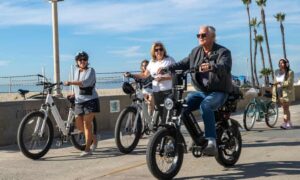
After several years of false starts, electric bikes are finally entering the American mainstream, amid booming sales of a multiplying number of models on offer and as more states offer incentives for people to ditch their cars and shift to two, motor-assisted, wheels.
This year could be considered “the year of the ebike”, according to John MacArthur, a transport researcher at Portland State University. Ebike sales in the United States leaped by 269% between 2019 and 2022, with the market size expected to have grown further in 2023, to be worth $2.59bn.
While ebikes took off in other parts of the world the US was slow to catch on, until the Covid pandemic, when streets were closed off, public transit numbers dropped and people were looking for alternative ways to get around. This, combined with city and state efforts to cut pollution from transportation to meet climate goals, has helped fuel an ebike surge that has no sign of abating.
“All these converging trends means that I think we’ll look back at this year and think this was an important moment,” said MacArthur. “Ebikes are in the zeitgeist, people are talking about them. They are inclusive of everyone. Even my mom is thinking of getting one.”
Nationally, Joe Biden’s administration has been fixated on shifting people from gasoline cars to electric cars, with tax credits worth up to $7,500 to people who want to get an EV. But there is no comparable federal support for buying an ebike, even though sales of ebikes now outstrip that of electric cars and many experts point to the superior benefits of the two-wheeled version, which emits less air pollution from tire wear and are safer in road accidents.
In lieu of this, there are more than 100 city and state-based incentives to boost ebike adoption across the US, according to a database compiled by MacArthur. One of the most significant ebike support packages could soon be put in place by New York, with the state senate passing a bill that offsets 50% of the purchase of a new ebike or electric scooter, up to $1,100.
Jabari Brisport, a Democratic New York state senator, said despite a delay he is optimistic that the bill will pass the lower house, the New York assembly, and be signed by the governor. “I haven’t heard of any pushback to the bill,” said Brisport, who occasionally uses a publicly shared ebike to get to his Brooklyn office.
“There is a lot of focus on moving people from one type of car to another type of car but there are other modes of transportation and ebikes are one of them. They are a low-carbon form of transportation that are great for getting around the city for short trips.”
Ebikes add a battery and a motor to the classic bicycle frame and provide a helping hand, as if someone were pushing at your back, when pedaling. There are different classifications of ebikes – some, with throttles that power the ebike independently of pedaling, can reach as fast as 28mph – but all are considered climate-friendly, even more so than electric cars. Globally, there are about 280m electric mopeds, bikes and scooters and, combined, these vehicles are already cutting demand for oil by about a million barrels a day.
But the rise of ebikes has greater connotations than just climate change, MacArthur points out. You can now get foldable ebikes, for commutes, or large cargo ebikes that can carry 550lb in weight. They can be used by people of different physical abilities. Half of all trips made by Americans are under three miles – a distance ebikes can easily conquer. Suddenly, cycling isn’t just a fitness activity or something done for fun by small children – it is a method to run errands and get to work in car-centric America.
